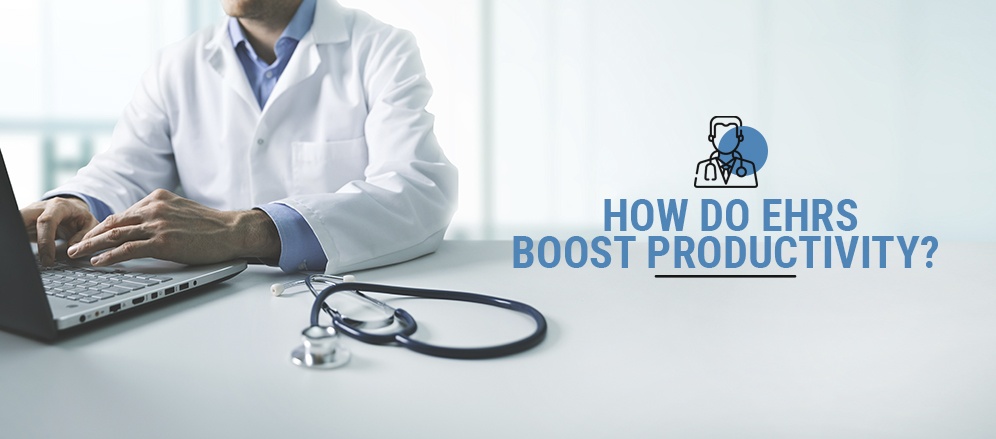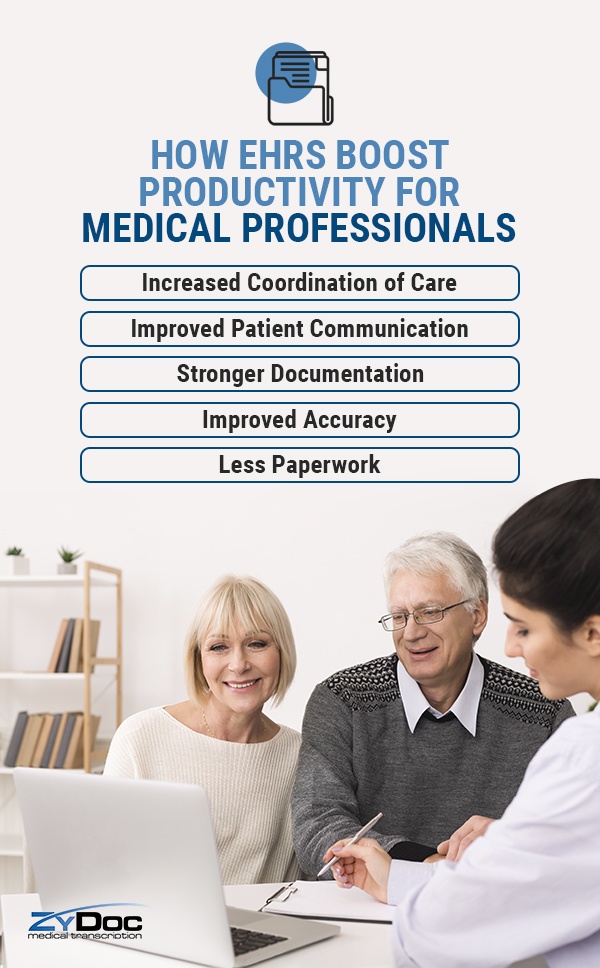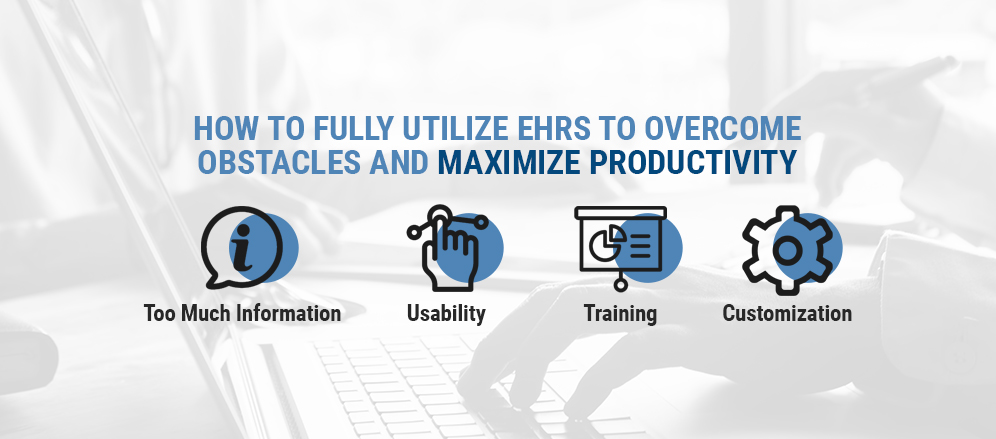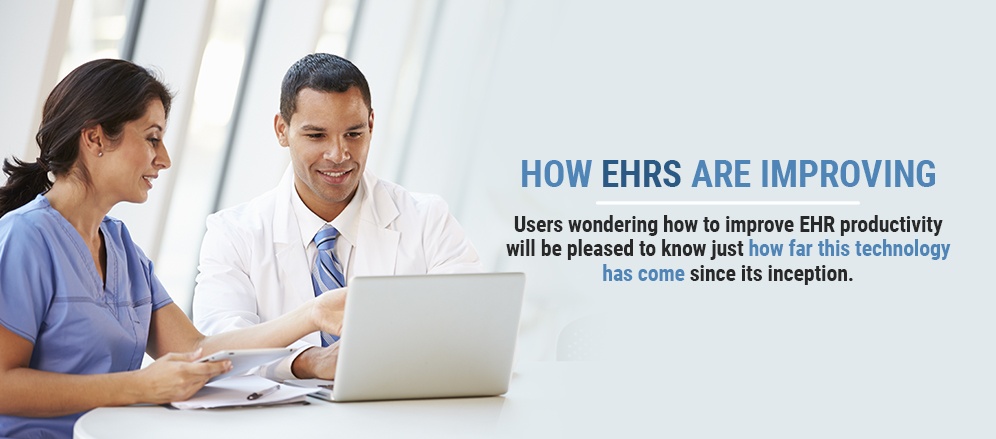How Do EHRs Boost Productivity?
Oct 13, 2020 | Jonathan Maisel
Physicians and their staff handle a high volume of patients, which translates into a massive amount of clinical data. Harnessing that data can help healthcare providers provide more efficient, insightful care. Electronic health record (EHR) systems can be a big part of driving further productivity in the world of digital medicine. More and more physicians are adopting EHRs and realizing how these systems can drive productivity in their practices. While the medical community has been vocal about some challenges presented by EHRs, these systems are maturing and overcoming the obstacles of the past.
In this guide, we’ll discuss how a health information system can increase productivity today.

How EHRs Boost Productivity for Medical Professionals
EHR efficiency is driven by a number of different factors, which can be a significant benefit for users. The benefits of EHR systems include:
1. Increased Coordination of Care
Coordinating care across multiple settings is always a challenge. A single patient might see physicians in different specialties at multiple offices and hospitals. While their care is so spread out, their medical records are essential to giving each one of their care providers an accurate picture of their needs. Multiple healthcare providers can access, view and update patient records in real-time on an EHR.
EHRs can also alert providers when there has been a significant change in a patient’s care. For example, an EHR can alert providers when one of their patients has been admitted to the hospital. These kinds of alerts can support continuity of care. Physicians can follow-up with their patients who have been discharged from the hospital.
With patient records organized and accessible via an EHR, multiple care teams can reduce the amount of duplicate and unnecessary tests.
2. Improved Patient Communication
Communication between patients and providers is an important piece of comprehensive, quality care. EHRs offer easy, secure communication via patient portals. Patients and doctors can message one another, all while viewing complete, accurate medical records. Care providers no longer have to look up paper records to ensure they are accurately communicating with patients. Additionally, patient access to their own medical records empowers them to ask informed questions.
The communication features of an EHR can also reduce the amount of time healthcare providers and their staff spend on the phone. Patients can schedule appointments, view test results and talk with their doctors via the patient portal. Patients who prefer the phone still have that option, but the EHR provides an efficient, comprehensive solution for patients who already organize a good deal of their lives through apps.
3. Stronger Documentation
Strong documentation is essential to creating a clear, accurate patient record. With the elimination of paper records, providers and their staff no longer need to struggle to decipher handwritten notes. Plus, EHR systems are designed to streamline the process of documentation. Templates help create a smooth clinical workflow for taking notes and populating the patient record. As physicians become accustomed to their practice’s system, they can become much more efficient at accurate, efficient documentation supported by the EHR. Plus, practices can outsource clinical documentation to companies that specialize in EHR transcription services.
4. Improved Accuracy
EHRs also have the potential to reduce the amount of error related to both patient care and billing. A complete, accessible patient record in and of itself is a valuable tool in avoiding potential errors. Additionally, EHRs provide alerts designed to prevent costly and dangerous errors. For example, an EHR can alert a user if a patient has already received a particular type of medication, if there are any potentially dangerous interactions with different drugs or if the patient has allergies.
When it comes to billing, complete and accurate documentation is essential. EHRs help streamline the billing process, which leads to a reduction in denied claims and ultimately leading to more revenue for healthcare providers. Plus, EHRs reduce the amount of time staff must spend gathering the necessary information for billing.
5. Less Paperwork
Paperwork can take up a significant amount of time for healthcare providers, which detracts from face time with patients. EHRs play a role in cutting down on paperwork. Patient charts, patient communication, test results and billing requests are all available through the EHR. Physicians can spend less time filling out paperwork by hand and less time searching for the relevant information when they need it. Plus, an EHR, which is completely digital, reduces the amount of necessary record storage space.
EHRs vs. EMRs
The acronyms “EHR” and “EMR” are often used interchangeably, but they actually refer to two very different technologies:
EHRs
EHRs serve as digital versions of patient records, but they do a lot more, as well. An EHR is designed to serve as a digital record of a patient’s care across all care settings. Lab technicians, specialists, primary care doctors, emergency department physicians and more can access an EHR and share information with one another. EHRs can also include a suite of features designed to improve clinical workflow efficiency. When selecting an EHR, you can look for features like e-prescribing, a patient portal, decision support, alerts and revenue cycle management.
EMRs
An electronic medical record (EMR) is a much less sophisticated and comprehensive technology than an EHR. An EMR, like an EHR, is a digital version of patient records. But, this is where the similarities end. While an EHR can be accessed by multiple users from anywhere, an EMR is tied to a specific practice. It is not shared across multiple users, which means it does not offer the wide-ranging benefits of care coordination that an EHR does. Additionally, an EMR does not have the extended capabilities of an EHR, like patient portals or billing support. EMRs are increasingly becoming outdated, particularly as certain standards push the industry toward EHRs.

How to Fully Utilize EHRs to Overcome Obstacles and Maximize Productivity
The road to EHR integration has not been without its bumps. Physicians have struggled with aspects of adapting the technology and using it to drive productivity. In fact, EHR adoption has been associated with increased administrative burden. So, why is a technology that’s meant to drive productivity sometimes seem to do the opposite?
Too Much Information
EHRs open the door to so much information. Users have thousands of patient records available at their fingertips. While that amount of information can be empowering, it can also be overwhelming. Users need to navigate the system to find the information they need when they need it. If you are new to an EHR or the system is not intuitive, it can seem like you are wasting a lot of time searching. Likewise, the way information is displayed can seem unhelpful. If users don’t know how to access and share the information they need, using an EHR quickly becomes frustrating and unproductive.
Usability
Usability is consistently one of the barriers to success with an EHR. If the healthcare provider cannot easily access and use the system, it quickly becomes an administrative burden that detracts from time with patients. Maybe the physician does not feel like the system is providing the right kind of workflow support. In this case, it can feel like the system is disrupting instead of supporting clinical workflow. If the system is lacking interoperability with other systems within the care setting or outside of it, users can quickly become frustrated by the inability to communicate. If entering information into the system feels clunky or difficult, clinical documentation will become time-consuming. All of these challenges reduce productivity and take away from the main goal of EHRs: efficient, quality care.
These obstacles are not insurmountable, but how do you boost EHR productivity? The answer is training and customization.
Training
Like any new technology, an EHR comes with a learning curve. Working with your EHR vendor and all front-end-users can help your EHR reach its maximum potential. Training is essential whether a hospital or physician practice is implementing a brand new EHR or upgrading an older system. When developing a training program, take into consideration who needs to learn how to use the system. How much, if any, experience have they had with EHRs previously? Are there any particular challenges users want to overcome? Tailor the training experience to your users and listen to their feedback. Educated users are empowered to get the most out of EHRs.
Healthcare organizations should also regularly test their EHR. What kinds of potential challenges will users encounter? How can an organization recognize and prevent those challenges? This type of preparation will ultimately mean a better, more efficient EHR user experience.
Customization
A “one-size-fits-all approach” does not necessarily work for an industry as varied as healthcare. EHRs and efficiency can go hand-in-hand when users have a say in how the system works. Physician practices and hospitals can customize EHRs to support their specific needs. For example, a single-specialty practice can customize an EHR to cater to that specific specialty, rather than to the needs of a large, multi-specialty practice. Similarly, a small, community hospital likely does not need the same EHR functionality as a healthcare system with multiple, large hospitals.
Customization can ultimately improve the user experience by saving time. Rather than searching through functions and clinical information that are irrelevant to the end-user, specialty EHR users can find what they need with just a few clicks. Customized EHRs can also display data in a way that is most meaningful to the specific user. Improved usability means more user satisfaction and more efficiency.

How EHRs Are Improving
Users wondering how to improve EHR productivity will be pleased to know just how far this technology has come since its inception. Health IT vendors have heard feedback from users, and they are creating better and better EHRs. EHRs have improved with greater:
Standardization
While EHR customization can be a major benefit, the vast difference between EHR systems presents a problem. Different EHRs may display patient records differently and have a different approach to medication management. The lack of unified standards has made using an EHR confusing and hindered interoperability.
But, things like the Health Information Technology for Economic and Clinical Health (HITECH) Act of 2009 and Promoting Interoperability Programs for Hospitals have driven standardization across the industry. EHR vendors need to design their products to meet measures outlined by the program because providers need Meaningful Use certified EHRs. The technology can no longer be as disparate as the industry places an increasing emphasis on interoperability and continuity of care. While standardization and interoperability are by no means completely achieved, EHRs have come a long way.
Flexibility
As EHRs have evolved, they have begun to offer a greater degree of flexibility. Physician practices and hospitals have the option to customize. Healthcare providers can also opt for cloud-based versions of EHRs. Cloud-based EHRs do not require the kind of space and infrastructure that an on-site server does. This means users have the flexibility to configure the system to their needs, even if those needs change frequently.
Plus, cloud-based EHRs offer a high degree of secure accessibility. Users can access all of the data and features of a cloud-based EHR from their device at any time. Mobile integration has made EHRs much more user-friendly in today’s world of smartphones and tablets. As EHRs continue to evolve, users will likely find more ways to use the technology to their advantage.
Affordability
EHR implementations are undoubtedly expensive due to upfront implementation and maintenance costs. Large hospitals and healthcare systems spend millions of dollars rolling out new EHR systems. But, the big market for EHRs means that there are more and more options. Healthcare providers have the option to shop around and find a system that fits their budget and their needs.
Plus, as EHRs have improved, and they have been able to drive cost savings. Less time spent on paperwork, better documentation, stronger coding capabilities and reduced errors translate into better practice management and efficiency. The more efficient a healthcare provider can be, the less time and money is wasted.
Boost Your Productivity With ZyDoc
EHRs have come a long way since first entering the healthcare scene, but the industry has yet to realize the full potential of this technology. Your EHR and productivity for your practice can still improve. Whether you are looking to roll out an EHR for the first time or upgrade your current system, you have a wide array of options to consider. As you learn how to use your new or upgraded system, there are plenty of ways to drive further productivity. While users certainly have a role to play in EHR efficiency, partners like ZyDoc can help too. Explore ZyDoc’s medical transcription and EHR documentation services to see how much more efficient your practice can be.

